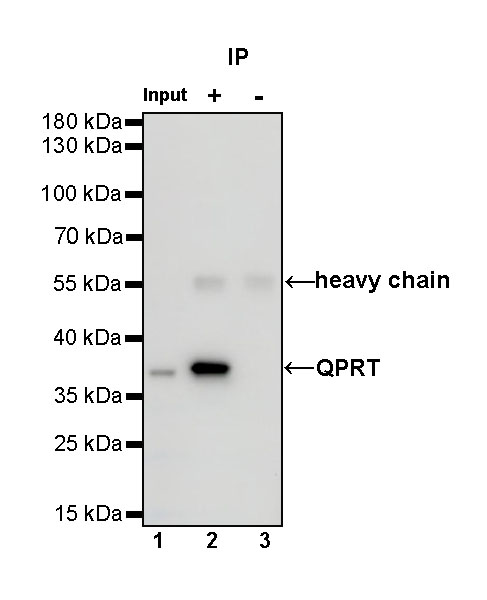12 months from date of receipt / reconstitution, -20 °C as supplied
| 应用 | 稀释度 |
|---|---|
| WB | 1:1000 |
| IHC-P | 1:1000 |
| IP | 1:50 |
QPRT, also known as Quinolinate Phosphoribosyltransferase, is an enzyme that catalyzes the conversion of quinolinic acid to nicotinic acid mononucleotide (NAMN) in the biosynthetic pathway of nicotinamide adenine dinucleotide (NAD+). This reaction involves the attachment of phosphoribosyl pyrophosphate (PRPP) to quinolinic acid, forming NAMN and pyrophosphate. QPRT plays a crucial role in maintaining the cellular NAD+ pool, which is essential for cellular metabolism, DNA repair, and other cellular functions. Abnormalities in QPRT activity or expression have been linked to various diseases, including cancer, neurodegenerative disorders, and metabolic diseases. In cancer, QPRT is often overexpressed, and its activity may contribute to tumor growth and progression. This is because NAD+ is a cofactor for many enzymes involved in cellular metabolism, including those that regulate glycolysis, fatty acid synthesis, and oxidative phosphorylation. By maintaining a high level of NAD+, QPRT may support the metabolic demands of rapidly proliferating tumor cells.
WB result of QPRT Recombinant Rabbit mAb
Primary antibody: QPRT Recombinant mAb at 1/1000 dilution
Lane 1: MDA-MB-231 whole cell lysate 20 µg
Lane 2: Jurkat whole cell lysate 20 µg
Lane 3: HeLa whole cell lysate 20 µg
Lane 4: MCF7 whole cell lysate 20 µg
Negative control: MDA-MB-231 whole cell lysate
Secondary antibody: Goat Anti-rabbit IgG, (H+L), HRP conjugated at 1/10000 dilution
Predicted MW: 31 kDa
Observed MW: 37 kDa

QPRT Rabbit mAb at 1/50 dilution (1 µg) immunoprecipitating QPRT in 0.4 mg HepG2 whole cell lysate.
Western blot was performed on the immunoprecipitate using QPRT Rabbit mAb at 1/1000 dilution.
Secondary antibody (HRP) for IP was used at 1/1000 dilution.
Lane 1: HepG2 whole cell lysate 20 µg (Input)
Lane 2: QPRT Rabbit mAb IP in HepG2 whole cell lysate
Lane 3: Rabbit monoclonal IgG IP in HepG2 whole cell lysate
Predicted MW: 31 kDa
Observed MW: 37 kDa
IHC shows positive staining in paraffin-embedded human kidney. Anti- QPRT antibody was used at 1/1000 dilution, followed by a HRP Polymer for Mouse & Rabbit IgG (ready to use). Counterstained with hematoxylin. Heat mediated antigen retrieval with Tris/EDTA buffer pH9.0 was performed before commencing with IHC staining protocol.
IHC shows positive staining in paraffin-embedded human liver. Anti- QPRT antibody was used at 1/1000 dilution, followed by a HRP Polymer for Mouse & Rabbit IgG (ready to use). Counterstained with hematoxylin. Heat mediated antigen retrieval with Tris/EDTA buffer pH9.0 was performed before commencing with IHC staining protocol.
IHC shows positive staining in paraffin-embedded human testis. Anti- QPRT antibody was used at 1/1000 dilution, followed by a HRP Polymer for Mouse & Rabbit IgG (ready to use). Counterstained with hematoxylin. Heat mediated antigen retrieval with Tris/EDTA buffer pH9.0 was performed before commencing with IHC staining protocol.
IHC shows positive staining in paraffin-embedded human tonsil. Anti- QPRT antibody was used at 1/1000 dilution, followed by a HRP Polymer for Mouse & Rabbit IgG (ready to use). Counterstained with hematoxylin. Heat mediated antigen retrieval with Tris/EDTA buffer pH9.0 was performed before commencing with IHC staining protocol.
IHC shows positive staining in paraffin-embedded human prostatic hyperplasia. Anti- QPRT antibody was used at 1/1000 dilution, followed by a HRP Polymer for Mouse & Rabbit IgG (ready to use). Counterstained with hematoxylin. Heat mediated antigen retrieval with Tris/EDTA buffer pH9.0 was performed before commencing with IHC staining protocol.
IHC shows positive staining in paraffin-embedded human colon cancer. Anti- QPRT antibody was used at 1/1000 dilution, followed by a HRP Polymer for Mouse & Rabbit IgG (ready to use). Counterstained with hematoxylin. Heat mediated antigen retrieval with Tris/EDTA buffer pH9.0 was performed before commencing with IHC staining protocol.
IHC shows positive staining in paraffin-embedded human lung adenocarcinoma. Anti- QPRT antibody was used at 1/1000 dilution, followed by a HRP Polymer for Mouse & Rabbit IgG (ready to use). Counterstained with hematoxylin. Heat mediated antigen retrieval with Tris/EDTA buffer pH9.0 was performed before commencing with IHC staining protocol.